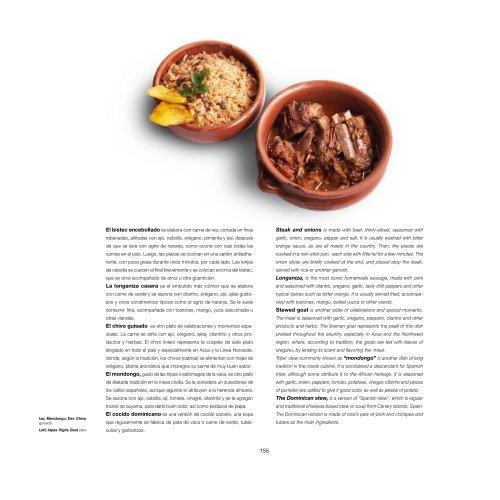Sabores-Ancestrales-Digital-1
You also want an ePaper? Increase the reach of your titles
YUMPU automatically turns print PDFs into web optimized ePapers that Google loves.
Izq. Mondongo. Der. Chivo<br />
guisado.<br />
Left, tripes. Right, Goat stew.<br />
El bistec encebollado se elabora con carne de res, cortada en finas<br />
rebanadas, aliñadas con ajo, cebolla, orégano, pimienta y sal, después<br />
de que se lava con agrio de naranja, como ocurre con casi todas las<br />
carnes en el país. Luego, las piezas se cocinan en una sartén antiadherente,<br />
con poca grasa durante unos minutos, por cada lado. Las lonjas<br />
de cebolla se cuecen al final brevemente y se colocan encima del bistec,<br />
que se sirve acompañado de arroz u otra guarnición.<br />
La longaniza casera es el embutido más icónico que se elabora<br />
con carne de cerdo y se sazona con cilantro, orégano, ajo, ajíes gustosos<br />
y otros condimentos típicos como el agrio de naranja. Se le suele<br />
consumir frita, acompañada con tostones, mangú, yuca salcochada u<br />
otras viandas.<br />
El chivo guisado es otro plato de celebraciones y momentos especiales.<br />
La carne se aliña con ajo, orégano, ajíes, cilantrito y otros productos<br />
y hierbas. El chivo liniero representa la cúspide de este plato<br />
elogiado en todo el país y especialmente en Azua y la Línea Noroeste,<br />
donde, según la tradición, los chivos (cabras) se alimentan con hojas de<br />
orégano, planta aromática que impregna su carne de muy buen sabor.<br />
El mondongo, guiso de las tripas o estómagos de la vaca, es otro plato<br />
de dilatada tradición en la mesa criolla. Se le considera un sucedáneo de<br />
los callos españoles, aunque algunos lo atribuyen a la herencia africana.<br />
Se sazona con ajo, cebolla, ají, tomate, vinagre, cilantrito y se le agregan<br />
trozos de auyama, para darle buen color, así como pedazos de papa.<br />
El cocido dominicano es una versión de cocido canario, una sopa<br />
que regularmente se fabrica de pata de vaca o carne de cerdo, tubérculos<br />
y garbanzos.<br />
Steak and onions is made with beef, thinly-sliced, seasoned with<br />
garlic, onion, oregano, pepper and salt. It is usually washed with bitter<br />
orange sauce, as are all meats in the country. Then, the pieces are<br />
cooked in a non-stick pan, each side with little fat for a few minutes. The<br />
onion slices are briefly cooked at the end, and placed atop the steak,<br />
served with rice or another garnish.<br />
Longaniza, is the most iconic homemade sausage, made with pork<br />
and seasoned with cilantro, oregano, garlic, tasty chili peppers and other<br />
typical spices such as bitter orange. It is usually served fried, accompanied<br />
with tostones, mangú, boiled yucca or other viands.<br />
Stewed goat is another plate of celebrations and special moments.<br />
The meat is seasoned with garlic, oregano, peppers, cilantro and other<br />
products and herbs. The lineman goat represents the peak of this dish<br />
praised throughout the country, especially in Azua and the Northwest<br />
region, where, according to tradition, the goats are fed with leaves of<br />
oregano, by lending its scent and flavoring the meat.<br />
Tripe’ stew commonly known as “mondongo” is another dish of long<br />
tradition in the creole cuisine. It is considered a descendant for Spanish<br />
tripe, although some attribute it to the African heritage. It is seasoned<br />
with garlic, onion, peppers, tomato, potatoes, vinegar, cilantro and pieces<br />
of pumpkin are added to give it good color, as well as pieces of potato.<br />
The Dominican stew, is a version of “Spanish stew”, which is regular<br />
and traditional chickpea based stew or soup from Canary Islands, Spain.<br />
The Dominican version is made of cow’s paw or pork and chickpea and<br />
tubers as the main ingredients.<br />
155


